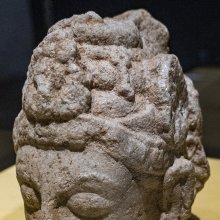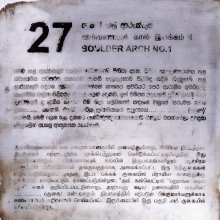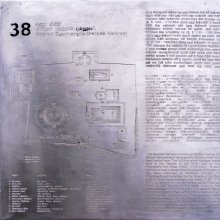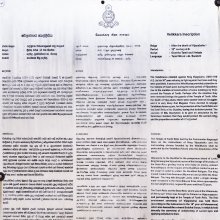Pihita: 15 definitions
Introduction:
Pihita means something in Hinduism, Sanskrit, Buddhism, Pali, Hindi. If you want to know the exact meaning, history, etymology or English translation of this term then check out the descriptions on this page. Add your comment or reference to a book if you want to contribute to this summary article.
Alternative spellings of this word include Pihit.
Images (photo gallery)
In Hinduism
Natyashastra (theatrics and dramaturgy)
Source: Wisdom Library: Nāṭya-śāstraPihita (पिहित, “resting”) refers to a specific gesture (āṅgika) made with the eyelids (puṭa), according to the Nāṭyaśāstra chapter 8. These gestures of the eyelids (puṭa) are supposed to follow the corresponding movements of the eyeballs (tārā). These gestures form a part of the histrionic representation (abhinaya).
Source: archive.org: Natya ShastraPihita (पिहित, “resting”).—A type of gesture (āṅgika) made with the eyelids (puṭa);—Instructions: when the eyelids are at rest (lit. closed). Uses: in dreaming (supta), fainting (mūrcchita), affliction due to storm (vātārti), hot smoke (uṣṇadhūmārti), rains (varṣārti) and collyrium (añjanārti) and eye-disease (netraroga).

Natyashastra (नाट्यशास्त्र, nāṭyaśāstra) refers to both the ancient Indian tradition (shastra) of performing arts, (natya—theatrics, drama, dance, music), as well as the name of a Sanskrit work dealing with these subjects. It also teaches the rules for composing Dramatic plays (nataka), construction and performance of Theater, and Poetic works (kavya).
Kavyashastra (science of poetry)
Source: Shodhganga: The Kavyavilasa of Ciranjiva Bhattacarya (kavyashastra)Pihita (पिहित) refers to one of the 93 alaṃkāras (“figures of speech”) mentioned by Cirañjīva Bhaṭṭācārya (fl. 17th century) in his Kāvyavilāsa and is listed as one of the 89 arthālaṃkāras (figure of speech determined by the sense, as opposed to sound).—The figure pihita has been first admitted by Rudraṭa in his Kāvyālaṃkāra (IX/50). Jayadeva in his Candrāloka (C.L.V/109) defines pihita.
Cirañjīva in the Kāvyavilāsa defines pihita-alaṃkāra as follows:—“pihitaṃ paravṛttāntajñānajñāpakaceṣṭitam”. According to Cirañjīva when an action in consequence of the knowledge of some incident or fact related to others is described it is the figure pihita. When an incident happens to one person and this incident is guessed by another who keeps mum and tries to do something to express that he is conversent with the incident or fact, the figure pihita takes place.
Example of the pihita-alaṃkāra:—
kutūhalavilokanasphuritacittamālokituṃ sthitāsmyamaravāhinīmiti mitaṃ vadantyāḥ sakhī |
nakhakṣatanirīkṣaṇātkucataṭe truṭatkañcuke skhalaccapalacelakāñcalamalaṅkaroti drutam ||“When the heroine was speaking to see the river of the gods (i.e., ganges), I was staying with quivering heart and curious gaze, the female friend observing the wounds by nails in the region of breasts from which the cloth became dropped, dressed quickly with the marginal portion with the loin cloth loosened and dropped”.
Notes: This verse expresses the incident of the heroine and her female friend. Here the female friend has known the love-tryst of the heroine in day time. Watching the signs of love-tryst the female friend has uttered nothing and kept mum but she is trying to dress her female friend from whose body the part of cloth has been dropped. The female friend by her action of dressing the heroine wants to mean that first of all the heroine should cover the wounds of nails in her breasts and then she may deceive her friend. Here the incident of the heroine is known to her female friend who acts afterwards accordingly without uttering any word. So this is an example of pihita.

Kavyashastra (काव्यशास्त्र, kāvyaśāstra) refers to the ancient Indian tradition of poetry (kavya). Canonical literature (shastra) of the includes encyclopedic manuals dealing with prosody, rhetoric and various other guidelines serving to teach the poet how to compose literature.
Languages of India and abroad
Pali-English dictionary
Source: BuddhaSasana: Concise Pali-English Dictionarypihita : (pp. of pidahati) shut; closed; covered.
Source: Sutta: The Pali Text Society's Pali-English DictionaryPihita, (pp. of pidahati) covered, closed, shut, obstructed (opp. vivaṭa) M. I, 118; III, 61; S. I, 40; A. II, 104; Nd1 149; J. I, 266; Miln. 102 (dvāra), 161; Vism. 185; DA. I, 182 (°dvāra). (Page 461)

Pali is the language of the Tipiṭaka, which is the sacred canon of Theravāda Buddhism and contains much of the Buddha’s speech. Closeley related to Sanskrit, both languages are used interchangeably between religions.
Sanskrit dictionary
Source: DDSA: The practical Sanskrit-English dictionaryPihita (पिहित).—p. p.
1) Shut, closed, barred.
2) Covered, concealed, hidden.
3) Filled or covered with; see अपिहित (apihita) also.
-tam A figure of speech which consists in insinuating to a person that one knows his secrets.
--- OR ---
Pihita (पिहित).—See under पिधा (pidhā).
Source: Cologne Digital Sanskrit Dictionaries: Shabda-Sagara Sanskrit-English DictionaryPihita (पिहित).—mfn.
(-taḥ-tā-taṃ) 1. Covered, hidden, concealed. 2. Filled with. 3. Shut, barred. E. api before, dhā to have, aff. kta, and the initial of the prefix rejected.
Source: Cologne Digital Sanskrit Dictionaries: Cappeller Sanskrit-English DictionaryPihita (पिहित).—[adjective] covered, concealed; checked, restrained.
--- OR ---
Pihita (पिहित).—v. apihita.
Source: Cologne Digital Sanskrit Dictionaries: Monier-Williams Sanskrit-English Dictionary1) Pihita (पिहित):—[=pi-hita] [from pi-dhā] a mfn. shut, hidden, concealed, covered or filled with ([instrumental case]), [Mahābhārata; Kāvya literature] etc.
2) [v.s. ...] n. a [particular] figure of speech which consists in insinuating to a person that one knows his secrets, [Kuvalayānanda]
3) [=pi-hita] b pi-hiti See pi-√dhā.
Source: Cologne Digital Sanskrit Dictionaries: Yates Sanskrit-English DictionaryPihita (पिहित):—[(taḥ-tā-taṃ) a.] Covered, hidden.
Source: DDSA: Paia-sadda-mahannavo; a comprehensive Prakrit Hindi dictionary (S)Pihita (पिहित) in the Sanskrit language is related to the Prakrit word: Pihia.
[Sanskrit to German]
Sanskrit, also spelled संस्कृतम् (saṃskṛtam), is an ancient language of India commonly seen as the grandmother of the Indo-European language family (even English!). Closely allied with Prakrit and Pali, Sanskrit is more exhaustive in both grammar and terms and has the most extensive collection of literature in the world, greatly surpassing its sister-languages Greek and Latin.
Hindi dictionary
Source: DDSA: A practical Hindi-English dictionaryPihita (पिहित) [Also spelled pihit]:—(a) covered; concealed, hidden, latent.
...
Kannada-English dictionary
Source: Alar: Kannada-English corpusPihita (ಪಿಹಿತ):—[adjective] covered; concealed; hidden; veiled.
--- OR ---
Pihita (ಪಿಹಿತ):—
1) [noun] the act of covering, concealing.
2) [noun] that which is coverd, concealed.
Kannada is a Dravidian language (as opposed to the Indo-European language family) mainly spoken in the southwestern region of India.
See also (Relevant definitions)
Starts with: Pihita Sutta, Pihitarajanasika, Pihitashrava.
Ends with: Anapihita, Apihita, Apupapihita, Bhujamgapihita, Protpihita.
Full-text (+13): Apihita, Pihiti, Pihia, Bashpapihitalocana, Lanchita, Bhujamgapihita, Supihitavat, Murcchita, Pihit, Ventapikiri, Vatarti, Samragayati, Netraroga, Vivata, Anjanarti, Supta, Samrageti, Varsharti, Ushnadhumarti, Dimbha.
Relevant text
Search found 10 books and stories containing Pihita, Pi-hita; (plurals include: Pihitas, hitas). You can also click to the full overview containing English textual excerpts. Below are direct links for the most relevant articles:
Women in the Atharva-veda Samhita (by Pranab Jyoti Kalita)
6g. Hymn to Imprecate Misfortune on a Woman < [Chapter 2 - The Strīkarmāṇi Hymns of the Atharvaveda]
Rig Veda (translation and commentary) (by H. H. Wilson)
Rig Veda 8.40.5 < [Sukta 40]
The Tattvasangraha [with commentary] (by Ganganatha Jha)
Verse 593-594 < [Chapter 10 - The Examination of the First Category—‘Substance’]
Matangalila and Hastyayurveda (study) (by Chandrima Das)
Avapāta: The fifth technique < [Chapter 3]
Vasudevavijaya of Vasudeva (Study) (by Sajitha. A)
Sanskrit Grammarians (1): Patañjali < [Chapter 5 - Impact of other Disciplines in Vāsudevavijaya]
Alamkaras mentioned by Vamana (by Pratim Bhattacharya)
1-2: The number of Alaṃkāras (poetic figures) mentioned < [Chapter 5 - A Comparative study of the different alaṃkāras mentioned by Vāmana]





